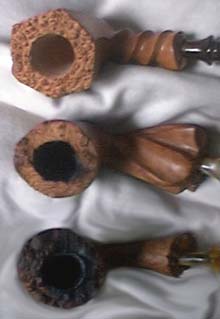
|
| Three steps in the transformation of a natural briar pipe, from unsmoked to heavily smoked |
Nevertheless, the pipe smoked well, and I didn't pay it any further attention other than it fell into rotation with my other pipes.
When I next encountered natural pipes (having met Mark Tinsky on the web), Mark sent me a selection of six to choose from, and I was in for another surprise. The natural pipe I had been smoking for a year or so was distinctively darker than this new lot. I came to the realization that a naturally finished pipe gradually evolves into new color variations, traveling from a deeper tan, to reddish browns, to dark browns. The contrast in grain also increases.
The first pipe in the photo, one of Mark's double twists, hasn't been smoked yet. (Yes, occasionally I'm capable of restraint.) The second, which is from one of my designs (the Star of Finland), has been smoked occasionally. The third is one of the several pipes I bought from that original selection of six. Nicknamed the Viking ship, because of its high prow, it has been smoked every day for some 2 years. I still wonder just how dark and rich it will become.
It seems that the typically stained pipe is nothing more than a natural pipe which has been smoked for several years. Perhaps it is the same difference between natural and precarbonized tobacco cavities, in which the black carbonization gives the illusion of a broken-in pipe. Whatever, given the choice these days, I'll always opt for a naturally finished pipe first. Each one is beautiful in its own way.

|